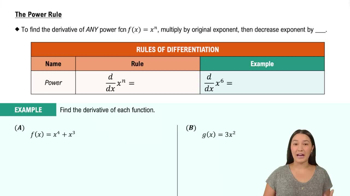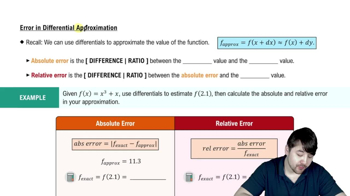Table of contents
- 0. Functions7h 52m
- Introduction to Functions16m
- Piecewise Functions10m
- Properties of Functions9m
- Common Functions1h 8m
- Transformations5m
- Combining Functions27m
- Exponent rules32m
- Exponential Functions28m
- Logarithmic Functions24m
- Properties of Logarithms34m
- Exponential & Logarithmic Equations35m
- Introduction to Trigonometric Functions38m
- Graphs of Trigonometric Functions44m
- Trigonometric Identities47m
- Inverse Trigonometric Functions48m
- 1. Limits and Continuity2h 2m
- 2. Intro to Derivatives1h 33m
- 3. Techniques of Differentiation3h 18m
- 4. Applications of Derivatives2h 38m
- 5. Graphical Applications of Derivatives6h 2m
- 6. Derivatives of Inverse, Exponential, & Logarithmic Functions2h 37m
- 7. Antiderivatives & Indefinite Integrals1h 26m
- 8. Definite Integrals4h 44m
- 9. Graphical Applications of Integrals2h 27m
- 10. Physics Applications of Integrals 2h 22m
4. Applications of Derivatives
Differentials
Problem 4.R.83
Textbook Question
82–89. Comparing growth rates Determine which of the two functions grows faster, or state that they have comparable growth rates.
x¹⸍² and x¹⸍³
 Verified step by step guidance
Verified step by step guidance1
Step 1: Understand the concept of growth rates. In calculus, when comparing growth rates of functions, we often look at their behavior as x approaches infinity.
Step 2: Consider the functions given: x^(1/2) and x^(1/3). These are both power functions, and their growth rates can be compared by examining their exponents.
Step 3: Recall that for power functions of the form x^a, the function with the larger exponent a will grow faster as x approaches infinity.
Step 4: Compare the exponents of the two functions: 1/2 and 1/3. Since 1/2 is greater than 1/3, the function x^(1/2) grows faster than x^(1/3) as x approaches infinity.
Step 5: Conclude that x^(1/2) grows faster than x^(1/3) based on the comparison of their exponents.
 Verified video answer for a similar problem:
Verified video answer for a similar problem:This video solution was recommended by our tutors as helpful for the problem above
Video duration:
5mPlay a video:
Was this helpful?
Key Concepts
Here are the essential concepts you must grasp in order to answer the question correctly.
Growth Rates of Functions
The growth rate of a function describes how quickly the function's value increases as the input variable grows. In calculus, we often compare growth rates using limits, derivatives, or asymptotic analysis to determine which function increases faster as x approaches infinity.
Recommended video:

Intro To Related Rates
Limits and Asymptotic Behavior
Limits are fundamental in calculus for analyzing the behavior of functions as they approach a certain point or infinity. Asymptotic behavior refers to the trend of a function as the input becomes very large, allowing us to compare functions by examining their limits at infinity to see which dominates.
Recommended video:

Cases Where Limits Do Not Exist
Power Functions
Power functions are expressions of the form f(x) = x^n, where n is a real number. The growth rate of power functions is determined by the exponent n; specifically, for large values of x, a function with a higher exponent will grow faster than one with a lower exponent, which is crucial for comparing x^(1/2) and x^(1/3).
Recommended video:

The Power Rule







